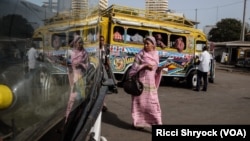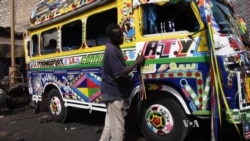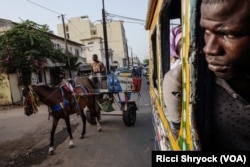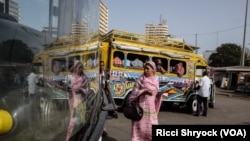Brightly painted cars rapide are a hallmark of Senegal’s capital, offering residents a cheap way to get around the city since 1976. But the privately owned minibuses are scheduled to be parked for good.
Cars rapide are being phased out as part of a plan to modernize urban transportation, says Alioune Thiam, general director of Dakar’s Executive Council on Urban Transport, speaking on the street.
As of December 2018, the minibuses no longer will circulate in the crowded capital city, whose population is estimated at 3 million. The minibuses are part of cultural heritage, Thiam says, but they don’t have the comfort and safety of modern transport. And they pollute a lot, raising environmental concerns.
As if on cue, the tailpipe of the car rapide just behind him exhales a giant plume of exhaust.
In 2005, Senegal began rolling out new buses, such as the Indian-made Tatas and the Chinese brand King Longs. It has introduced over 1,300 of these modern buses. They are bigger and more comfortable than cars rapide, but they, too, are often packed during rush hour, a testament to Dakar's exploding population.
But some passengers still prefer the cars rapide.
One rider, Christina, says they are faster than the Tatas.
With the changeover, riders will also have to deal with increased fares. A ride across town that now costs about 25 cents (150 CFA) will go up to about 35 cents (200 CFA).
Of course, passengers are not the only ones who will be affected.
Moussa Sock has been behind the wheel of a car rapide for nearly 20 years. I love this job, he says. It’s my work and I’ve done it since I was very young.
Authorities say Moussa won’t lose the job he loves. The state plans to bring on car rapide drivers and apprentices to operate the new buses after the changeover in 2018. And some people are even suggesting that artists give the new buses a car rapide-style makeover.
They have a distinctive look. The cars rapide are painted in bands of blue, white and yellow and adorned with colorful lettering and images.
Neyoo Diallo, a car rapide artist, explains the iconography is far from random.
At the front of the car rapide, we put two eyes, like a man has two eyes, he says. We paint horses because before there were cars, even our spiritual guides had horses, so that’s why we put those.
For now, the car rapides still barrel through Dakar’s streets. But they, too, will soon be in this city’s rearview mirror.















